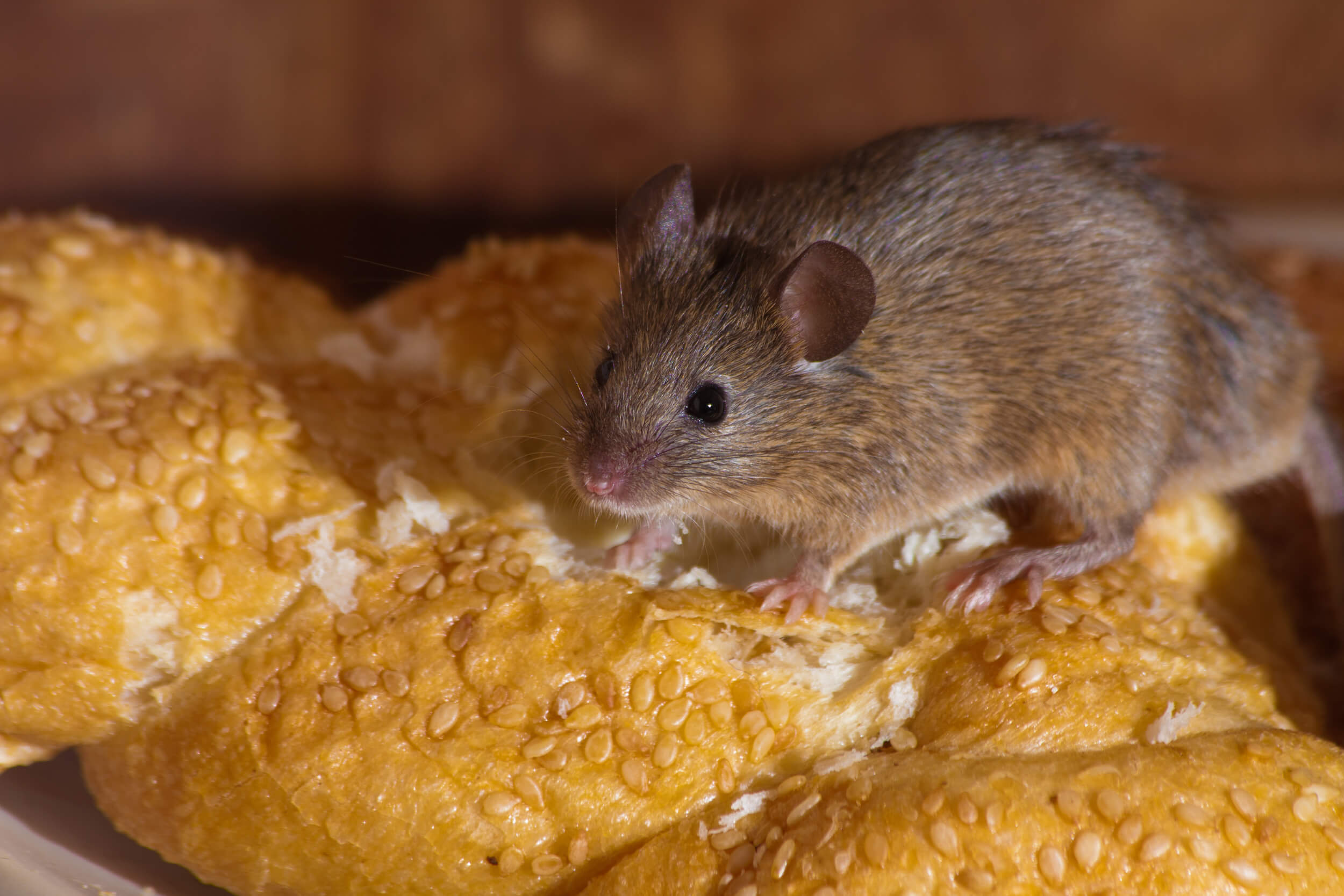House Mouse
Scientific Name:
Mus Domesticus
Appearance:
Small and slender, three to four inches long, with large ears, small eyes and pointed nose; light brown or light gray; droppings are rod-shaped.
Habits:
Nest within structures and burrow; establish a “territory” near food sources, generally 10 to 30 feet from nest; inquisitive, but very wary; excellent climbers.
Diet:
Omnivorous, prefer cereal grains.
Reproduction:
Prolific breeders at two months; can have litters as often as every 40 or 50 days, with four to seven young per litter; live up to one year.
Other Information:
Feed 15 to 20 times per day; can squeeze through a hole one-fourth inch wide; carry many serious diseases.
Pack Rat
Scientific Name:
Neotoma spp.
Appearance:
Medium-sized, bodies measure about 8 inches, with the tail slightly shorter than the head and body combined. Varies in color from cinnamon to brown, gray, yellowish gray, or creamy buff.
Habits:
Pack rats get their name from their habit of taking small, bright or shiny objects and hoarding them in their nests. They will take can tabs, bottle caps, bits of foil, coins, and jewelry just to name a few items.
Diet:
After establishing themselves within a building, pack rats will feed on foods within the building but will continue to forage for most of their food outdoors.
Other Information:
Pack rats are distinguished from Norway or roof rats by having more hair on the ears than either of the other two rats.
Norway Rat
Scientific Name:
Rattus Norvegicus
Appearance:
Brown, heavy-bodied, six to eight inches long; small eyes and ears, blunt nose; tail is shorter than head and body; fur is shaggy; droppings are capsule-shaped.
Habits:
Nest in underground burrows, from which they enter buildings in search of food; tend to remain in hiding during the day.
Diet:
Omnivorous, but prefer meats; cannot survive long without water.
Reproduction:
Reaches sexual maturity in two months; can breed any month of the year; litter may number from eight to twelve; females can have four to seven litters per year; adults live as long as one year.
Other Information:
Most common rat in U.S.; limited agility, but excellent swimmer; carrier of many serious diseases.
Deer Mouse
Scientific Name:
Peromyscus maniculatus
Appearance:
The deer mouse is small in size, only 3 to 4 inches (8 to 10 cm) long, not counting the length of the tail. They have large beady eyes and large ears giving them good sight and hearing. Their soft fur can vary in color, from white to black, but all deer mice have a distinguishable white underside and white feet
Habits:
Deer mice are nocturnal creatures who spend the day time in areas such as trees or burrows where they have nests made of plant material.
Diet:
Deer mice are omnivorous; the main dietary items usually include seeds, fruits, arthropods, leaves, and fungi. Throughout the year, the deer mouse will change its eating habits to reflect on what is available to eat during that season.
Reproduction:
The female deer mouse can reproduce at all times of the year, though in most parts of their range deer mice breed from March to October. Typical litters are composed of three to five young, and a deer mouse will average three to four litters per year.
Other Information:
The deer mouse is a vector and carrier of emerging infectious diseases such as hantavirus and lyme disease. More information regarding hantavirus can be found at: https://www.cdc.gov/hantavirus/
We are the go-to
Pest & Termite Control Company in southern Colorado
Over 40 years of Experience 100% Satisfaction Guaranteed
With over 40 years of experience, locally owned and operated, Mug-A-Bug will treat your home with respect and care no matter the size of the job. All technicians are certified and use only federally approved products to ensure your family’s safety. 100% satisfaction is guaranteed.
We offer residential and commercial pest removal in Several different programs and our ant exterminator team services all of Colorado Springs as well as the Pueblo area. Let Mug-A-Bug help remove any unwanted pests and take back your home today!
Mug-A-Bug Pest Control
Education about common Colorado Pests
While some pests don’t bite or sting, they can still cause damage to your home or business. They are unwanted guests that you need to have removed. In Southern Colorado’s unique climate, it is possible to inadvertently invite them into our homes. We hope this guide helped you find and identify some of the common Colorado pests. Education about common Colorado pests can help you identify what the problem is so we can better serve you.
